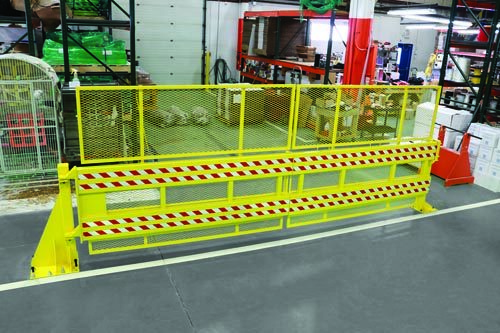Fall hazard awareness
What are some slip, trip and fall hazards we might be overlooking?

Responding is Ed Wieczorek, chief marketing officer/quality manager, US Netting, Erie, PA.
In January 2017, a new rule from OSHA on “Walking-Working Surfaces and Personal Protective Equipment (Fall Protection Systems)” took effect. This rule upgraded fall-safety requirements for general industry, bringing them to the same level as existing mandates in the construction industry. Slips, trips and falls remain consistently high on the list of causes of work-related injuries and deaths. Many opportunities for such incidents may exist in your facility – some you might not have considered.
Slips and falls on the same level (caused by a wet floor, an oil spill or other inadequate maintenance) are bad enough. Falls to a lower level can cause even greater injury. Anytime a height difference of 4 feet or more exists, fall protection is required. Mezzanine areas are one example of where steel guardrails should be installed.
Other wall and floor openings – including pits, skylights and ladder openings – also need to be protected. Cordoning such areas with a simple chain barrier may not be sufficient. Steel barriers or hatch netting provide stronger solutions.
Fall prevention measures may need to be improved around major equipment, such as hoppers, grinders and crushers; or vats containing acid or other chemicals. The Mine Safety and Health Administration reported that on March 26 a miner at a limestone operation was seriously injured when a motor he was removing from a crusher fell and knocked him off a 7.5-foot work platform. Although some ease of access is necessary to operate and maintain such equipment, protection such as guardrails, safety netting or covers should be implemented.
Loading docks are extremely hazardous areas and common fall sites. Again, chains aren’t adequate for preventing falls. Heavy-duty safety nets (wall- or bollard-mounted) or steel barrier gates are the safest solution. They can keep people, products or even forklifts from falling off the dock.
Fall injuries don’t result only from personnel taking a tumble. They also can occur if workers are struck by flying or falling materials. Hard hats and steel-toed boots offer some protection, but more effective prevention stops hazards at the source. For example, pallet racks loaded with inventory can be wrapped with rack safety netting (secured with zip ties or bracketed kits) to keep products from falling and injuring workers, or simply from becoming damaged.
If your plant involves people working on multiple levels, consider placing custom debris nets under mezzanines to prevent dropped tools or materials from hitting workers (or even machinery) on lower levels. Don’t let the phrase “throwing a monkey wrench into the works” become literal.
If any machinery in your plant is under pressure – including tanks, cisterns or piping for systems such as ventilation – then Kevlar nets and blast blanket systems are excellent safety measures. These can be custom-fitted to contain explosions and other major equipment failures, keeping dangerous debris from flying through the air and damaging other equipment – or injuring or killing workers.
Workplace injuries carry tremendous costs for the worker and the company. It’s well worth taking a walk through your plant and looking carefully for potential fall hazards. With the variety of solutions available, there is no excuse for failing to invest in fall prevention.
Editor's note: This article represents the independent views of the author and should not be construed as a National Safety Council endorsement.
Post a comment to this article
Safety+Health welcomes comments that promote respectful dialogue. Please stay on topic. Comments that contain personal attacks, profanity or abusive language – or those aggressively promoting products or services – will be removed. We reserve the right to determine which comments violate our comment policy. (Anonymous comments are welcome; merely skip the “name” field in the comment box. An email address is required but will not be included with your comment.)

